Copyright © 2006 Mel Copeland. All rights reserved.
The Lydian language
Translation of Lydian scripts
by Mel Copeland
(Based on a related work, Etruscan Phrases,
first published in 1981)
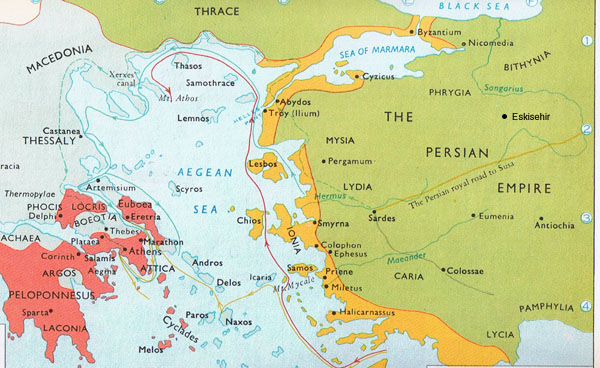
About the Translation
The Lydian language is known from about 100 inscriptions, many of which date circa. 500 B.C. (the map above shows western Anatolia at the time of the Persian wars, 492-480 B.C., from Barnes & Noble, Inc., NY, "Historical Atlas of the World," 1971). It is believed to be the distant relative of Hittite and other Luwian languages. Accepting this as a fact I never inquired into the language – beyond correlating Lydian, Lycian and Hittite words in Etruscan Phrases Indo-European Table 1, of word relationships. I took at their word the experts' records of the languages. However, a small bilingual inscription in Greek and Lydian (Script J) resembled Etruscan writing / language patterns. So I decided to revisit the Lydian scripts about the 23rd of June 2006. Quite frankly I expected Lydian to be similar to Etruscan which is close in grammatical and morphological relationships to Latin, Italian and French (See Etruscan Phrases).
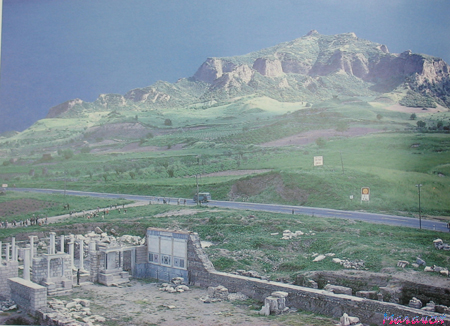 |
|
Sardes, capital of Lydia. View of the Acropolis looking south (1969) (1) |
 |
| Tumulus of "Alyattes," near Sardes, capital of Lydia. (1) |
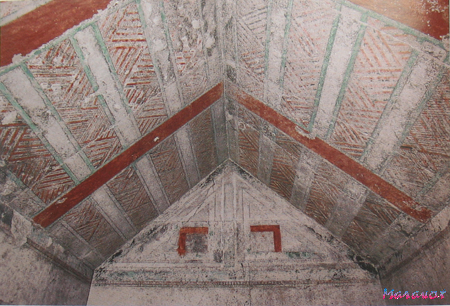 |
| Tomb, Lala Tepe, Ahmeth, near Sardes, capital of Lydia. (1) |
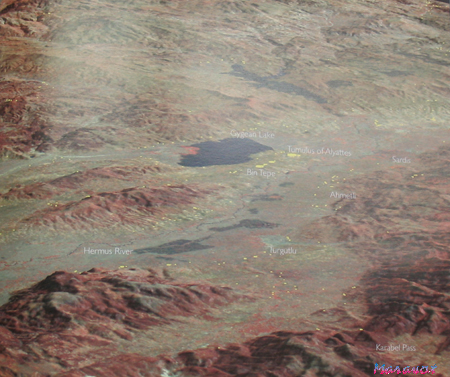 |
| Tumuli, Bin Tepe, "A thousand tumuli," near Sardes, capital of Lydia. The tumuli are marked by yellow dots (1) See Phrygian.html for a discussion on the distribution of the tumuli in Anatolia and an overall view of the diffusion of the Indo-Europeans at Etruscan Phrases.a.html |
This is the first presentation (draft) of those findings which involved nine scripts. I have given every word in the scripts an alpha-numeric locater, following the Etruscan Phrases work, which includes about 1,700 Etruscan words. Fundamental to the Etruscan decipherment and this work is the criteria that all languages have rules (grammar) and language presupposes repetition. Thus, to decipher a script one isolates repititious words and phrases. And in the isolation process conjugation and declension patterns (a characteristic of grammar) are revealed. Without giving consideration to the meaning of any words in a language, at this stage – of isolating words, phrases and conjugation and declension patterns – one can be sure that a language has been isolated. Using the comparative process with the words, their conjugation and declension patterns, one may be able to ascertain close relationships to a known language.
In the case of Etruscan, for the past two thousand years since it became extinct, scholars – many charlatans among them – attempted to decipher that language. Only one Etruscan expert, Staccioli (2), succeeded in establishing for the scholastic world an Etruscan vocabulary, and that vocabulary entailed about 60 words – all of which were accepted as non-Indo-European. Staccioli's work was not correct, but his legacy continues to haunt accounts by scholars on the origin and language of the Etruscans. A Google search will demonstrate this easily enough.
This work is a work in progress, like Etruscan Phrases, and will change as I work the site. I found over the years that the internet / html is the best way to analyze and present the decipherment and translation of Etruscan and now Lydian. The reason for this is that the data are easier to edit in html and one can color syllables and characters that represent a declension or conjugation pattern so to make them stand out. Also, as in Etruscan Phrases Indo-European Table 1 coloring shifts in words through the Indo-European language groups helped highlight linguistic connections more easily.
The Etruscans are believed to have originated in Lydia. According to Herodotus and others they left the land as a result of a long drought following the Trojan War. If that myth were true, I concluded long ago – since the Etruscan language is most closely related to Latin – that the Lydians may have spoken a language similar to Latin. The Italic tribes may, in fact, have originated in Anatolia and spread into Italy at the time the Greeks spread into the Greek mainland.
To test this theory of an Etruscan-Lydian linguistic group one would have to address the Lydian language. Also, since Lycian and Carian are language groups adjacent to Lydia in Anatolia, one might be tempted to reexamine those languages. However, my hunch is that Carian ought to be distinctly different from Lydian based upon Homer's account, in the Illiad, where he refers to the Carians as speaking a foreign language (as opposed to the Trojans and their other allies versus the Greeks). In the Catalogue of Ships invading Troy (Illiad Book II) In addition to listing the Greek allies – of many languages he says – Homer lists the allies of Troy, many of whom can be located on the map on this page. They are
Hector Priamides commanded the Trojans. He had under his own hand much the larger division of armed spearmen, and the best men.
The Dardanians were led by Aineias son of Anchises. His mother was the divine Aphrodite, who lay with Anchises on the foothills of Mount Ida, goddess with mortal man. With Aineias were the two sons of Antenor, Archeolochos and Acamas, complete warriors both.
Those who came from Zeleia under the lowest foot of Ida, and drank the water of the Aisepos, wealthy men and Trojans, were led by Lycaon's son Pandaros, who received his bow from Apollo himself.
Those who came from Adresteia and the land of Apaisos, from Pityeia and the steep hill of Tereia, were led by Adrestos, and Amphios in his linen corselet, two sons of Percosian Merops. He understood divination beyond all others, and he forbade his sons to go to the war; but they disobeyed him, since the fate of black death drove them on.
Those who came from Percote and Praction, from Sestos and Abydos and sunny Arisbe, were led by Asios Hyrtacos' son. He came from Arisbe besides the river Selleeis driving great chestnut horses.
Hippothoös led the bands of Pelasgian spearmen, those who are settled on the rich soil of Larisa: Hippothoös and Pylaios, that true sprig of Ares, the two sons of the Pelasgian Lethos Teutamos' son.
The Thracians were led by Acamas and Peiroös, all those enclosed by the strong-flowing Hellespont.
Euphemos was the leader of the Ciconian spearmen. He was a son of Prince Troizenos Ceades.
Pyraichmes led the Paeonians with curving bows. He brought them a long way, out of Amydon from the broad river Axios, from Axios, the finest waster that runs over the earth.
The Paphlagonians were led by hairy Pylaimenes from the Enetai, where the wild she-mules are found. They were settled at Cytoros and Sesamos about the river Parthenios, at Cromna and Aigialos and lofty Erythinoi.
The Alizones were led by Odios and Epistrophos, from Alybe far away, where silver has its birth.
The Mysians were led by Chromis, and Eunomos the diviner of birds; but his birds did not save him from black death, for he was brought low by the hand of Achilles at the river, when Achilles despoiled other Trojans too.
Phorcys led the Phrygians, and noble Ascanios, from distant Ascania: they were eager to join in the fray.
The Meionians were led by Mesthles and Aniphos, two sons of Talaimenes born beside the Gygaian lake; they brought the Meionians from their birthplace under Tmolos.
Nastes again led the Carians, men of barbarous speech, who came from Miletos, and the leafy mountain of Phthira, from the streams of Maiandros and the high peaks of Mycale. Amphimachos and Nastes were their leaders, Nastes and Amphimachos the fine sons of Nomion. One came to the war all over gold, like a poor girl. Poor fool! It did not save him from cruel death; but he was brought low by the hands of Achilles at the river, and prudent Achilles carried off the gold.
Sarpedon and the admirable Glaucos led the Lycians, out of far-off Lycia, from the eddying Xanthos.
The glossary of Lydian words includes relationships to Etruscan words in the Etruscan Glossary. The characters in the alphabet shown on this page produce this glossary. Differences with translators who claim that Lydian is Luwian, related to Hittite, include their characterizations of the letter we show as an "E" which they translated as a "D." Like Etruscan the "D" seems to be rare, and where the "D" is co nventionally used the "T" is represented. Another character that seems to require greater examination is the "P" which has been transcribed as an "L" most of the time. The transcriptions available to me at this time simply don't differentiate a "P" versus an "L," and those transcriptions may be incorrect. The "C" is not used. The "K" is represented, as in Etruscan, by two characters as shown, the "T" also is represented by two characters as shown (sometimes the Etruscan rendering, as in the Tavola Cortonensis, is like a "Y." The "M" and "N" are rendered similarly to the Etruscan. Etruscan does not use an "O," omega and the character "V" serves as that vowel and sometimes as a "u." The two characters of Lydian that are the vowel "i" appear in Etruscan. The
nventionally used the "T" is represented. Another character that seems to require greater examination is the "P" which has been transcribed as an "L" most of the time. The transcriptions available to me at this time simply don't differentiate a "P" versus an "L," and those transcriptions may be incorrect. The "C" is not used. The "K" is represented, as in Etruscan, by two characters as shown, the "T" also is represented by two characters as shown (sometimes the Etruscan rendering, as in the Tavola Cortonensis, is like a "Y." The "M" and "N" are rendered similarly to the Etruscan. Etruscan does not use an "O," omega and the character "V" serves as that vowel and sometimes as a "u." The two characters of Lydian that are the vowel "i" appear in Etruscan. The is rare in Etruscan and has been read as "ae." The
is an "S" in Etruscan but definitely serves as a vowel, "A," in the Lydian scripts. The "R" is represented by three characters in Etruscan and only the "P" in Lydian. Letters peculiar to Etruscan – not yet seen in Lydian – include the "Q" and "ph." The "Q" is generally represented by a "C" in Etruscan and the Ø "ph" and
"th" also appear to be missing from Lydian. In Etruscan the "ph" is generally used in words that coincide with Greek words/spellings, such as Phare, light, lighthouse. The character "B" is rare in Etruscan and transcriptions of the character in Lydian as a "B" as opposed to a "V" require further scrutiny. In any event this is the result of applying reading techniques for Etruscan to Lydian, resulting in a language, like Etruscan, that is close to Latin. The close proximity of Lydian to Latin may be sufficient to cast doubts on any correlations to Hittite / Luwian.
The Lydian alphabet shown here is rough, to say the least and will be updated when more scripts and good photo copies of the scripts can be reviewed. Characters used in the Etruscan scripts may be reviewed at the Lemnos_Script.html.
Click here for a spreadsheet of the words, Lydian Glossary.xls or Lydian_Glossary.html
![]()
Script A – Lydian text from a Lydian-Aramaic bilingual
A1 – RAUIS IS LU BAKI / VAKI PLU USTuM RUE (Roi) FINiK [Translation: you fall /rush down (L. ruis) LU (there) of Bacchus I lament, weep (L. ploro-are) of the dry, burnt (L. uro, urere, ussi, ustum, to burn, dry up) the king (Fr. roi) I bind (L. vincare)]
– RAUIS IS LU BAKI / VAKI PLU USTuM RUE (Roi) FINiK [Translation: you fall /rush down (L. ruis) LU (there) of Bacchus I lament, weep (L. ploro-are) of the dry, burnt (L. uro, urere, ussi, ustum, to burn, dry up) the king (Fr. roi) I bind (L. vincare)]
A9 – PATRIS AK TV LAK KUE KIT IST US UVAN [Translation: the fathers (L. pater-tris) ...you (L. tu) .... you assemble (L. coeo-ire) that of yours (L. iste) of the mouth (L. os) rejoicing (L. ovans-antis)]
A17 – VUTAR FOE AKAE MANU LIE KVM PILI EA KITUS [Translation: to vow (L. voveo, vovere) .....of the hand (L. manus-i) of the lioness (L. lea-ae) with (L. cum) the pillar (L. pila-ae) it is (L. eat, subj.) of Kitus]
A27 – UMRE VUKUS US UVAN AU VUK FIS SAS [Translation: Omre the hearth (L. focus-i) or we summon (L. voco-are) of the mouth (L. os) rejoicing (L. ovans-antis) oh! (l. au!) I call / summon (L. voco-are) ......]
A35 PATIR ISAS VUKIT KUE ISTUS UVAN AU VUTARU [Translation: the father (L. pater-tris) Isas he calls (L. voco-are) you assemble, to collect (L. coeo-ire) that of yours (L. istoc) rejoicing (L. ovans-antis) oh! (l. au!) of the future? (L. futurus-a-um) or alternatively you will vow (L. voveo-vovere)]
A42 AKTIN NATIS TV LUK VINSU IVIE VAK MU ARTIMUS [Translation: they drive, set in motion (L. ago, agere) the nation, born (L. natus-a-um) of you (L. tu) ...I conquer, overcome (L. vinco, vincere) in the same place? (L. ibid, ibidem); I make void (L. vaco-are) myself (L. me) Artimus]
A51 IV SIM SIS ARTIM UK KUPUS SIS A ARAU VIRA UK [Translation: there at that place (L. ibi) I am (L. sim, subj.) you wish (L. sis) close (L. artus-a-um) .. the abundance (L. copia-ae) you wish (L. sis) by (L. a) Arau, name, to be thirsty, dry (L. areo-ere) the man (L. vir-viri) swifter? (L. occios-occior)]
A56 KUIE AU KOVU UK TIRA UTUPU Ke VIRU UK VATINT [Translation: you assembled? (L. coeo) .. .....the earth (L. terra-ae) Utupu to us (It. ce) to be vigorous (L. vireo) .. they beat (L. battuo)]
(End of Text)
Script B This is a bilingual script in Lydian and Greek from "Pergamon," Gusmani, 1964-1986, No. 40
B1 – VESTA IR_ O AKV Lu [Translation: to the goddess of the earth, Vesta ...I am engaged upon (L. ago, agere) there (Fr. la)]
IR_ O AKV Lu [Translation: to the goddess of the earth, Vesta ...I am engaged upon (L. ago, agere) there (Fr. la)]
B5 – BARTARAS PACIT [Translation: Bartaras he pacifies (L. paco-are)
Script C, Lydian text L.16, Buckler 1924
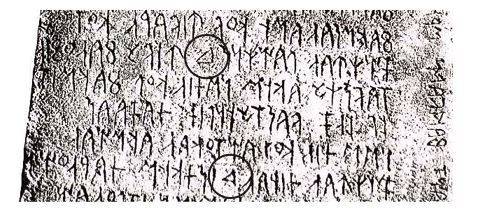
C1 – 8AKuM SAFAM U KOF KI FARE KOT V.. [Translation: Empty (L. vacuus-um) of kisses (L. savium-a) ..who, which (L. qui) the grain (L. far, faris) of the grindstone (L. cos, cotis) .
C8 – SUIKAE LA UINS KIVU (KIFV) VAE OVIE [Translation: the furrows, paths (L. suicus-i) there (la) the shouting of Euan, of Bacchanais (L.euans-antis) of anything (L. quivis) or alternatively of food (L. cibus-i) alas! (L. vae!) the sheep (L. ovis-is)]
C-14 – ES (from line C8)TAFI IS AKEMNA TIE KOP VAK (8AK) MITF [Translation: you have wasted away (L. es, you are, + tabeo-ere, to waste away) this person (L. is, ea, id) of Agememnon? the day (L. dies-ei) or god, (L. deus-i, divus, di, dii, divi, dea, diva) ... I wander (L. vagor-ari) I dispatch (L. mitto, mittere)]
C22 – Lu FES VASTeS UN LIT TASA AS [Translation: there (la) the wearied, tired (L. fessus-a-um) of the void, empty, wasted (L. vastus-a) one (L. unus-a-um) I bring an acceptable offering (L. lito-are) of the yew tree? (L. taxus-i) whole (L. as, asgis, whole divided into 12 parts)]
C28 – NAM TIE KOPAI TOKA TAK MU AESU (SU from next line) [Translation: for (L. nam) the day (L. dies-ei) of abundance (L. copia-ae) the toga (L. toga-ae) alternatively, he touches (It. toccare) of yours (L. te) .. mine (L. meus, my mine) copper, ore (L. aes-aeris)]
C32 – EKAR TIRAU IST KIM TARE OUKS [Translation: to be in need (L. egeo-ere) threwn?(It. tirare) that of yours (L. ist) I sigh (L. gemmo-are) the earth (L. terra-ae) it enlarges (L. augeo, augere)]
(End of text)
 Script D – from the Necropolis
Script D – from the Necropolis
D1 – USI FANAS A TALIS TIU ALIS TARUS AL LIS [Translation: you disturbed, parched (L. uro, urere, ussi, ustum) the temple and land? (L. fanum-i) to (L. a) such (L. talis-e) by day (L. diu) the winged (L. ales-altis) bull (L. taurus-i) to the (It. al) legal action (L. lis, litis)]
D10 – AKIN KUE KASA URUS AK TV (or AKTV) SAS TIE SIFuM Me LIE [Translation: they will move (L. ago, agere) you assemble, collect (L. coeo-ire) the house (L. casa-ae) of Orus; alternatively, we speak (L. oro-are) .. you , or possibly to set in motion (L. ago) .. the day (L. dies-ei) ...me lioness? (L. lea-ae)]
D20 – MUOLA SRVAS TIE MIU A LIE MUOLA AK NATIS [Translation: Muola you serve (L. servio-ire) or alternatively you watch over (L. servo-are) the day (L. dies-ei); Muola ..of the nation, born (L. natus-a-um)]
D29 – IMU KANAU KIPVU VUKUM IN A ZUS ASKI TAPAE (or TALAE) [Translation: on the contrary (L. immo) Cannea? to sing, chant, prophesy (L. canto-are) of the cippus, tombstone? (L. cippus-i) called (L. voco-are) in (L. in) to (L. a) the hog, swine (L. sus, suis) you adopted (L. ascio-scire) the stake or bar (L. talea-ae)]
D39 – VAE INT VAK MU ARTIMUS TIRAU TV LUK VK VATINT [Translation: Woe! (L. vae!) from there (L. inde) I make (L. facio, facere) myself (L. meus) Artimus fearful, frightful (L. dirus-a-um) to you (tu) the light (L. lux, lucis) they beat (L. battuo)]
 Script J – Bilingual in Lydian and Greek
Script J – Bilingual in Lydian and Greek
J-1 – NANNAS BAKI FALIS ARTIMUU
Greek: Nannas Dionysi kleos Artemidi
[Translation : Nannas, or alternatively, funeral dirge (L. nenia-ae) of Bacchus the pillar (L. fala [phala] -ae) of Artemidi] Note: The Lydian word, FALIS, must coincide with the Greek word, KLEOS. The goddess Artemis (Roman Diana) was the daughter of Zeus and Leto and the sister of Apollo. According to some accounts, brother and sister were both born on the island of Delos. According to others, Artemis was born on the neighboring island of Ortygia and, shortly thereafter, assisted her mother in giving birth to Apollo on Delos. The brother and sister avenged their mother not long afterward by shooting Tityus, the giant who had tried to rape Leto before their birth. Later they shot all or nearly all the children of Niobe because the Theban queen had boasted of her superiority to Leto, who had only two children.
Artemis and Apollo remained close friends, often hunting together. Artemis, in fact, spent most of her time in hunting, in the company of various nymphs who she required to remain virgins like herself. Orion, among several suitors, attempted to violate Artemis, according to some accounts, and was killed by her. A more usual version of the tale has it that Artemis and Leto persuaded Zeus to immortalize Orion, their former companion on the hunt, as a constellation after Ge had sent a scorpion to kill him because of a boast that had offended her. Other accounts say that Artemis killed Orion because he challenged her to a game of quoits, or because he raped Opis, or because he lay with Eos.
Artemis was remarkably jealous of her honors, even for an Olympian deity. When Admetus inadvertently failed to include her among those to whom he sacrificed at his wedding, he led his bride to their bedchamber only to find it filled with snakes. Oeneus, king of Calydon, once neglected to dedicate the firstfruits of the year's harvest to her and was punished when his entire land was ravaged by a monstrous bear. Agamemnon received even more severe treatment for idly boasting that he could hunt as well as Artemis. The goddess sent unfavorable winds to keep the entire Greek fleet, which Agamemnon commanded, at Aulis. She then demanded – if the priest Calchas was to be believed – the sacrifice of Agamemnon's fairest daughter. Some say that when the sacrifice was carried out, she substituted a deer on the altar and spirited Iphigenia away to the land of the barbaric Taurians to be her priestess there. Some accounts claim that the original cause of Artemis' enmity toward Agamemnon was no act of his but rather the failure, long before, of his father, Atreus, to sacrifice the best lamb of his flock to the goddess. he had promised it to her, but when it was born with a golden fleece, he hid it instead of sacrificing it.
In spite of Artemis' familiar reputation in both art and literature as a chaste huntress, most scholars agree that she was originally far from a virginal goddess; moreover, she was certainly not Greek. In cult she was a patroness of all young living things, animal or human. At Ephesus, where her great temple was one of the "seven wonders of the world," she (or a goddess early identified with her) was depicted grotesquely with many breasts, an obvious symbol of motherhood. It is generally believed that Artemis was originally a mother-goddess similar to the Minoan "Lady of the Wild Things" and the Phrygian Cyble. At Brauron, her chief cult center in Attica, her preistesses were probably dressed as bears, and the bear Callisto may have been a local form of Artemis herself. Among the Greeks she became, paradoxically, a virgin goddess of childbirth.
As a guardian of wild animals Artemis was invoked by hunters. Several of her companion nymphs or priestesses seem to have ben either versions of Artemis herself or similar local goddesses who were assimilated to her worship. Iphigeneia was almost certainly a form of Artemis. The goddess' association with the moon was a widespread, but late, development, as was her name Phoebe. Diana, a Roman goddess of fertility, was sufficiently like Artemis to make their identification considerably more plausible than in the cases of several other major deities. (3)
Of interest is an Etruscan mirror, Divine_Mirror.html, that gives the entire account of Helen of Troy, the queen of Sparta who was abducted from her husband Menelaus (Agamemnon's brother), and taken off to Troy by Paris, the prince of Troy (also called Alexandros). In this mirror Diana is represented, with her deer, and her name is called MEAN. Wikipedia.org says of Lydia that both Herodotus and Homer refered to the Lydians as Meiones. While in the Divine_Mirror.html we indicated that name of MEAN appeared to be "Latin Maenaas-idis [f], a bacchante, a prophetess" it may in fact relate to Artemis as the patroness of Lydia, i.e., the Meiones.
Lydian script E
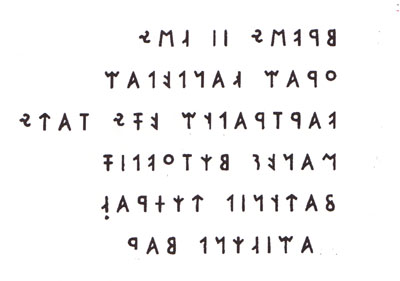
E1 – BRUAS II EAS
E4 – ORAU KANLU LAU [Translation: the boundaries? (L. ora-ae) of the channel (L. canalis-is) I praise; praise (L. laudo-are; laus, laudis)
E7 – FAR TRA LUU USI TAKS [Translation: the grain (L. far, faris) you pull, take up (L. traho, trahere) ..burnt, dry (L. uro, urere, ussi, ustum, to burn, dry up) you bury, cover up? (L. tego, tegere) or alternatively, you silence (L. taceo-ere)]
E12 – MANUS VITOU ULIS [Translation: the hand (L. manus-i) of life? (L. vita-ae) you smell (L. oleo-ere)]
E15 – BAKI NIL KITRAI [Translation: to the Bacchants nothing (L. nil, nihil) of the Kitrai]
E18 – _AUIE IN Lu 8AR [Translation: ...in (L. in) there (la) I change (L. vario)]
Notes:
1) Scripts A, B, C Michael Everson Working Group Document, International Organization for Standarization, proposal to encode the Lycian and Lydian scripts.
2) Romolo Augusto Staccioli, "La Lingua degli Etruschi, Edizioni di Archeoloia," Roma, 1977 and "Il Mistero della Lingua Etrusca," Newton Compton, Roma, 1977. A copy of Mel Copeland's work, "Catalogue of Etruscan Words," 1981, was sent to a cardinal in the Vatican at the time of publication. The catalogue pointed out the errors in Staccioli's work. The cardinal wrote a letter back saying, "How dare you criticize my friend Staccioli's work!" From that day, because of the fanatic desire to protect the old expert's research, it was apparent then, and continues to this day, that any work on the Etruscan language would have difficulty getting the attention of Etruscan specialists. Making things worse, there have been so many charlatans that have claimed to decipher the Etruscan language the publishing world is reluctant to entertain any work on the language.
3) Mythological accounts are based upon Edward Tripp's "The Meridian Handbook of Classical Mythology, NY, 1970.
![]()
Notes:
(1) From "The City of Sardes – Approaches in Graphic Recording," Crawford H. Greenewalt Jr., et al., Harvard University Art Museum, Cambridge, 2003
(2) Romulo Augusto Staccioli, "La Lingua degli Etruschi," Edizioni di Archeologia, Roma," 1970 and "Il Mistero della Lingua Etrusca," Newton Compton, Roma, 1977. Staccioli was not the first to introduce the "Glossary" that was developed through guesswork, without concern for the requirement that all words in the Etruscan language must reflect a grammar. I received an email from a man in Italy that kindly pointed out that Massimo Pallotino, "The Etruscans," first published by Ulrico Hoepli, Milan, 1942 (My copy, the Indian University Press, 1975) was the first to introduce the problem Glossary, which modern university experts have used to bamboozle the scholastic world into believing that Etruscan is not an Indo-European language. Yet the scholars represent that they have "translated" the language.
Launched 6.26.06
Updated: 6.27.06; 7.08.06; 7.11.06
Visitors
Copyright © 2006-2007 Maravot. All rights reserved.
Copyright © 2006-2007 Mel Copeland. All rights reserved.
Use of the information on this page for publication in any media is forbidden without the prior written consent of the author.
